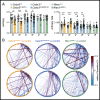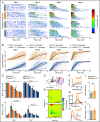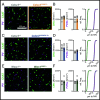Human mutations in high-confidence Tourette disorder genes affect sensorimotor behavior, reward learning, and striatal dopamine in mice
- PMID: 38683996
- PMCID: PMC11087812
- DOI: 10.1073/pnas.2307156121
Human mutations in high-confidence Tourette disorder genes affect sensorimotor behavior, reward learning, and striatal dopamine in mice
Abstract
Tourette disorder (TD) is poorly understood, despite affecting 1/160 children. A lack of animal models possessing construct, face, and predictive validity hinders progress in the field. We used CRISPR/Cas9 genome editing to generate mice with mutations orthologous to human de novo variants in two high-confidence Tourette genes, CELSR3 and WWC1. Mice with human mutations in Celsr3 and Wwc1 exhibit cognitive and/or sensorimotor behavioral phenotypes consistent with TD. Sensorimotor gating deficits, as measured by acoustic prepulse inhibition, occur in both male and female Celsr3 TD models. Wwc1 mice show reduced prepulse inhibition only in females. Repetitive motor behaviors, common to Celsr3 mice and more pronounced in females, include vertical rearing and grooming. Sensorimotor gating deficits and rearing are attenuated by aripiprazole, a partial agonist at dopamine type II receptors. Unsupervised machine learning reveals numerous changes to spontaneous motor behavior and less predictable patterns of movement. Continuous fixed-ratio reinforcement shows that Celsr3 TD mice have enhanced motor responding and reward learning. Electrically evoked striatal dopamine release, tested in one model, is greater. Brain development is otherwise grossly normal without signs of striatal interneuron loss. Altogether, mice expressing human mutations in high-confidence TD genes exhibit face and predictive validity. Reduced prepulse inhibition and repetitive motor behaviors are core behavioral phenotypes and are responsive to aripiprazole. Enhanced reward learning and motor responding occur alongside greater evoked dopamine release. Phenotypes can also vary by sex and show stronger affection in females, an unexpected finding considering males are more frequently affected in TD.
Keywords: Tourette disorder; behavior; mouse models; neuroanatomical findings.
Conflict of interest statement
Competing interests statement:The authors declare no competing interest.
Figures







Update of
-
Human mutations in high-confidence Tourette disorder genes affect sensorimotor behavior, reward learning, and striatal dopamine in mice.bioRxiv [Preprint]. 2023 Nov 28:2023.11.28.569034. doi: 10.1101/2023.11.28.569034. bioRxiv. 2023. Update in: Proc Natl Acad Sci U S A. 2024 May 7;121(19):e2307156121. doi: 10.1073/pnas.2307156121. PMID: 38077033 Free PMC article. Updated. Preprint.
References
Publication types
MeSH terms
Substances
Grants and funding
LinkOut - more resources
Full Text Sources
Medical
Molecular Biology Databases

